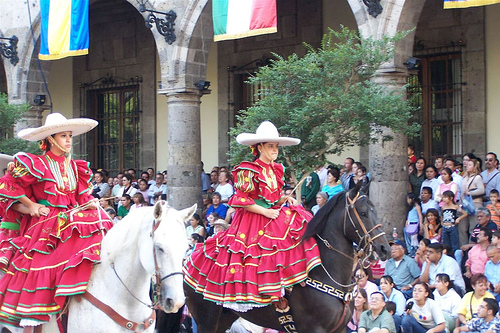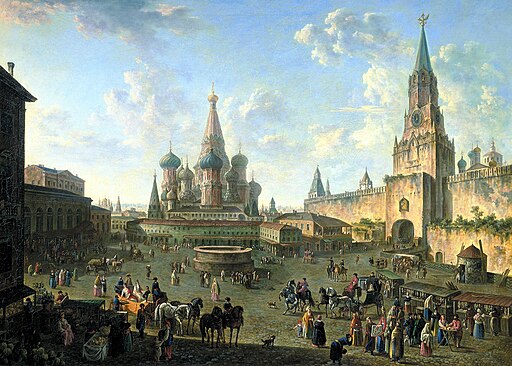
This Benin Ivory Mask is a miniature sculptural portrait of the Queen Mother Idia of the 16th century Benin Empire. The sculpture takes the form of a traditional African mask and features a beaded headdress and choker at her neck. The forehead shows ritual scarification highlighted by iron inlay on the forehead. The mask is framed by the flange of symbolic beings and with heads representing the Portuguese, symbolizing Benin’s alliance with the Europeans. This type of hip-mask was worn by the King, on the hip, during important ceremonies. The mask has double loops at each side for attachment of the pendant.
The mask represents Queen Mother Idia, who was the mother of Esigie, a renowned ruler of the Edo people who ruled in the early 1500s. The Queen Mother played a very significant role in the reign of her son. She was a great warrior who mobilized an army for her son Esigie, who defeated his rival and half-brother to become the 16th king of Benin. His mother, Idia, received much of the credit for these victories. It was her political counsel and her significant influence, which lead to success on the battlefield.
Esigie came to power as Portuguese explorers first made contact with the empire. Trade and diplomacy with Europe brought Esigie, and his kingdom prosperity and influence as his empire traded pepper, ivory, textiles, and slaves for brass, cloth, beads, and mercenaries. Images of the Portuguese continued to appear in Benin art long after their presence in Benin had diminished.
The Kingdom of Benin was a pre-colonial kingdom in what is now southern Nigeria, and its capital was Edo, which is now known as Benin City. The Benin Kingdom was one of the oldest and most highly developed states of West Africa, dating to the eleventh century CE until the British Empire annexed it in 1897.
The British Benin Expedition of 1897 was a punitive expedition by British forces that captured, burned, and looted Benin City, with much of the country’s art and treasures taken as booty. About forty percent of the art was accessioned into the British Museum. Some works were given to members of the Military as spoils of war. The rest was sold to pay for the cost of the British expedition.
The dispersal of the Benin art to museums around the world was a catalyst for the slow European reassessment of the value of West African art. Benin art was copied, and its style integrated into the art of many Western artists.
Benin Art
Benin art from the Kingdom of Benin or Edo Empire (1440–1897), is primarily made of cast bronze and carved ivory. It was produced mainly for the court of the Oba of Benin, a ruler for whom the craftsmen created a range of ceremonially significant and extraordinary objects. The Western appreciation of Benin art is primarily as works of art. However, its significance is much broader, it also acts as a remarkable historical record. Artifacts and as mnemonic devices to reconstruct history, or as ritual objects.
Benin Ivory Mask
- Title: Benin Ivory Mask
- Date: Early 16th century
- Culture: 16th century Benin Empire
- Medium: Ivory, iron inlay
- Dimensions: H: 9 3/8 in (23.8 cm); W: 5 in (12.7 cm); D: 3 1/4 in (8.3 cm)
- Museum: Metropolitan Museum of Art – MET
Kingdom of Benin
- Dates 1180–1897
- Capital: Edo (now Benin City)
- Languages: Edo
- Geography: Part of modern-day Nigeria
Explore the Metropolitan Museum of Art
MET European Paintings Collection
- “Pygmalion and Galatea” by Jean-Léon
- “Saint Jerome as Scholar” by El Greco
- “Portrait of Juan de Pareja” by Diego Velázquez
- “Camille Monet on a Garden Bench” by Claude Monet
- “View of Toledo” by El Greco
- “The Musicians” by Caravaggio
- “The Death of Socrates” by Jacques-Louis David
- “The Harvesters” by Pieter Bruegel the Elder
- “Young Woman Drawing” by Marie-Denise Villers
- “The Grand Canal, Venice” by J. M. W. Turner
- “The Houses of Parliament (Effect of Fog)” by Claude Monet
- “Madame Cézanne in a Red Dress” by Paul Cézanne
MET Modern and Contemporary Art Collection
- “Reclining Nude” by Amedeo Modigliani
- “Improvisation 27 (Garden of Love II)” by Wassily Kandinsky
- “Jeanne Hébuterne” by Amedeo Modigliani
- “The Card Players” by Paul Cézanne
- “Bathers” by Paul Cézanne
MET Greek and Roman Art Collection
- Statue of a Kouros
- Amathus Sarcophagus
- Mycenaean Terracotta Female Figures
MET Egyptian Art Collection
- The Temple of Dendur
- The Sphinx of Hatshepsut
- William the Faience Hippopotamus
MET Asian Art Collection
- Luohan – Yixian Glazed Ceramic Sculpture
- Pillow with Landscape Scenes – Zhang Family Workshop
- Jar with Dragon
MET Ancient Near Eastern Art Collection
- Sumerian Standing Male Worshiper
- Head of a Beardless Royal Attendant – Eunuch
- Human-Headed Winged Bull (Lamassu)
MET American Wing Collection
- “Washington Crossing the Delaware” by Emanuel Leutze
- “Portrait of Madame X” by John Singer Sargent
- “Mother and Child” by Mary Cassatt
- “Fur Traders Descending the Missouri” by George Caleb Bingham
- “The Gulf Stream” by Winslow Homer
MET Islamic Art Collection
- Blue Qur’an
- Marble Jar of Zayn al-Din Yahya Al-Ustadar
- The Damascus Room
MET Arts of Africa, Oceania, and the Americas Collection
- Benin Ivory Mask
- African Face Mask – Kpeliye’e
- Sican Funerary Mask – Peru
- Ceremonial Axe – Papua New Guinea
MET European Sculpture and Decorative Arts Collection
- “Hercules the Archer” by Antoine Bourdelle
- “Orpheus and Eurydice” by Auguste Rodin
- “Perseus with the Head of Medusa” by Antonio Canova
MET Medieval Art Collection
- “The Last Supper” by Ugolino di Nerio
- Plaque with the Journey to Emmaus and Noli Me Tangere
- Doorway from the Church of San Nicolò, San Gemini
MET Drawings and Prints Collection
- Album of Tournaments and Parades in Nuremberg
- “Canvassing for Votes” by William Hogarth
- “Christ and the Woman of Samaria” by Rembrandt
MET Costume Institute Collection
- Bodice
- Cardinal Cape
- Doublet
MET Arms and Armor Collection
- Blade and Mounting for a Sword (Katana)
- Double-Barreled Flintlock Shotgun
MET Photograph Collection
- Loie Fuller Dancing
- Sala Delle Statue, Vatican
- Gardner’s Photographic Sketchbook of the War
MET Musical Instrument Collection
- Ming-Dynasty Pipa
- Grand Piano
- Bass Fluegel Horn in B-flat
Explore the MET
- The MET Cloisters
- Met Breuer
- Metropolitan Museum of Art – MET
Reflections
- The first European travelers to reach Benin were Portuguese explorers. Did the Queen Mother Idia play a role in establishing friendly relations with the Portuguese?
- What influence did African art have on the developments of western modern art?
- Have you seen other examples of Benin art?
- Do you see this object primarily as works of art, or as historical artifacts, or as a device to reconstruct history, or as a ritual object?
~~~
“One who knows kindness and benevolence,
let them so be kind and helpful.”
– Edo Proverb
~~~
Photo Credit: [CC0], via Wikimedia Commons
Popular this Week








 Sponsor your Favorite Page
Sponsor your Favorite Page SEARCH Search for: Search Follow UsJoin – The JOM Membership Program
Sponsor a Masterpiece with YOUR NAME CHOICE for $5
Share this:
- Tweet
